
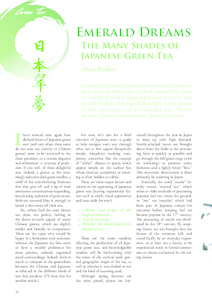 |
|
I have noticed time again how diehard lovers of Japanese green teas (and very often these same do not take too warmly to Chinese greens) seem to be attracted to the clean precision, to a certain elegance and refinement, a certainty of perfection, if you will, of these delightful teas. Indeed, a glance at the stunningly seductive dark green needles, a whiff of the overwhelming freshness that they give off, and a sip of their sometimes consciousness-expanding, intoxicating explosion of grass-sweet, fresh-air, seaweed bliss is enough to knock a first-timer off their seat.

Yet, others find the taste almost too clean, too perfect, lacking in the down-to-earth appeal of many Chinese greens, which are slightly milder and friendly in comparison. These are the types who would be happy in a bohemian-style teahouse, whereas the Japanese tea fans seem to have a notable preference for more pristine, ordered, organized social surroundings. Indeed, there is much to compare in the generalities between the Chinese and Japanese as reflected in the different kinds of teas they produce. (I'll leave that for another article.)
For now, let's aim for a brief overview of Japanese teas - a guide to help navigate one's way through what can at first appear deceptively simple. Simplicity masking complexity, somewhat like the concept of "shibui": objects or spaces which appear simple on the surface but whose intricate complexity or meaning is often hidden or subtle.
There are three major factors and criteria in the appraising of Japanese green teas (leaving experiential factors such as smell, visual appearance and taste aside for now):
These are the main variables affecting the production of all Japanese green teas, and knowledgeable vendors will be forthcoming with the name of the cultivar used, general geographic origin of the tea, as well as whether it was shaded or not and the kind of steaming used.
Although spring harvests are the most prized, plants are harvested throughout the year in Japan to keep up with high demand. Freshly-plucked leaves are brought down from the fields to the processing farm as quickly as possible and go through the kill-green stage (with no withering) to preserve color, freshness and a lightly bitter "bite." This enzymatic deactivation is done primarily by steaming in Japan.

Ironically, the word "sencha" literally means "roasted tea," which refers to older methods of processing Japanese leaf tea, versus the ground, or "mo," tea (matcha), which had been part of Japanese culture for centuries before steeping leaf tea became popular in the 17th century. The processing of sencha was developed in the 18th century. By steeping leaves, tea was brought into the houses of the common folk and could finally be an everyday experience, or at least not a luxury to be experienced rarely in formal ceremonies or almost exclusively by the ruling classes.
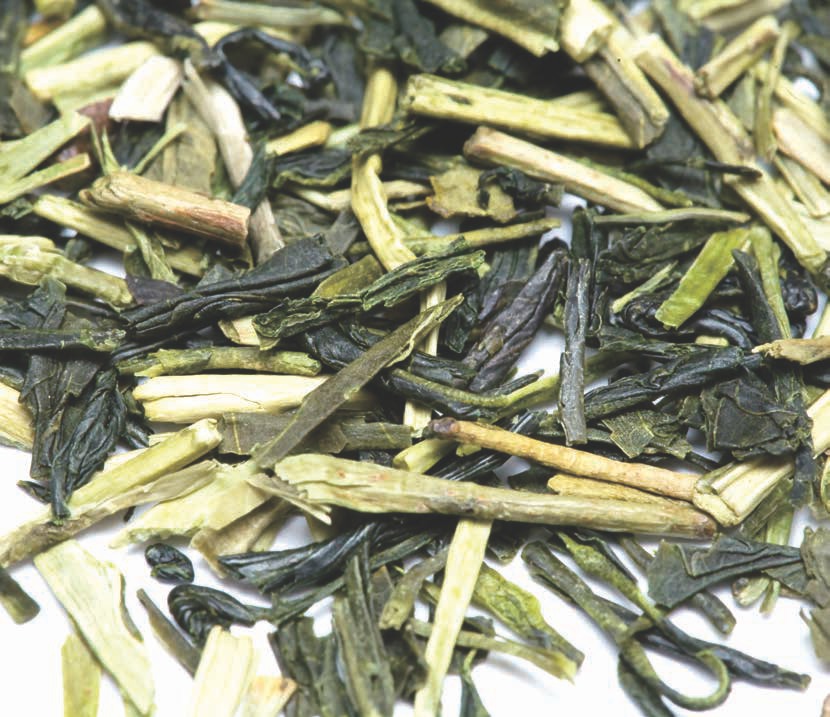
Although Japan produces almost only green tea (their red and oolong teas are far from refined in taste, but exciting to try - until the 1960s, when cheaper African and Indian red teas came to dominate the world market, Japan produced quite a bit of red tea), the differences between the kinds of green tea can be staggering.
Here's a very, very brief introduction to some of the different kinds of green teas you may find in Japan.
There are four main categories of Japanese green tea: bancha (late-harvest, or "common" tea), sencha, gyokuro and matcha. Sencha accounts for over 80% of all tea produced in Japan, bancha about 10%, matcha about 2% and growing, and gyokuro, which can be among the world's most expensive teas, about 0.3%. There is also a miniscule production of hei cha (black, fermented teas), which the Japanese make very differently from the way shou puerh or Liu Bao are produced in China, for example. One popular kind of post-fermented Japanese tea is called "batabatacha," definitely an acquired taste - best boiled, it has a unique pickled flavor, which mellows after several steepings and is an excellent summertime drink.
Both matcha and gyokuro are made with so-called "shaded leaves." Entire plantations and tea gardens are shaded from the sun for a few days to several weeks before harvesting. The materials used to shade the plants as well as the length of shading time, plus the gradient of shading, all influence in very distinct ways the resulting taste of the tea. Shading causes numerous changes in the leaf, which increase umami (a difficult word to translate, it means a kind of savoriness or full-bodied flavor), sweetness and intensity. Other kinds of teas, which can be considered subdivisions of sencha and bancha teas, include those listed below.
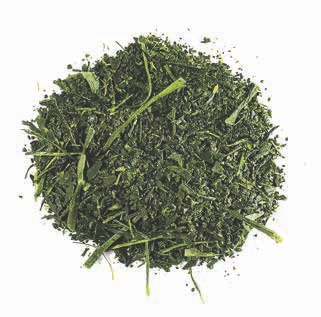
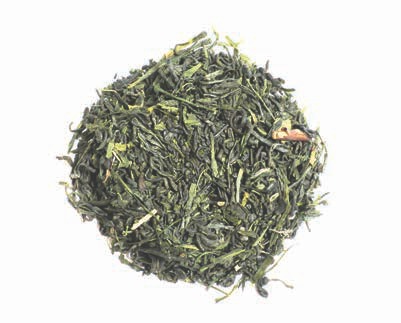

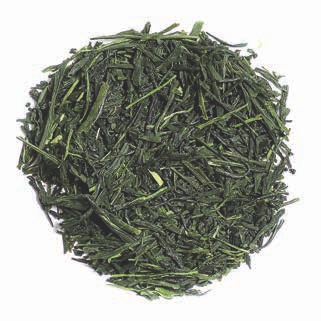
Although the words "varietal"and "cultivar" are often used interchangeably, in botany, a "varietal" is used to indicate naturally-occurring differences in related subspecies of a plant; "cultivars" are human-made subspecies created from cross-breeding and hybridization (often from stem cuttings). Cultivar is short for "cultured varieties." A brief look at Japanese tea cultivars would be instructive, as they play a major role in Japanese tea farming, with their vastly different taste profiles, crop yields and "personality characteristics." Cultivars have been registered officially in Japan since 1953. Understanding how different cultivars behave in different circumstances helps to ensure stable crop yields and avoids potential disasters created by monocultures.

As domestic consumption of tea started to soar in the 1970s, Japanese tea farmers looked for a way to reduce dependency on importing tea from elsewhere and increase domestic production. The Yabukita varietal at this point became king, and even today, some 75% of all teas produced in Japan are made from Yabukita leaves. This particular strain offers a pungent and pleasant umami taste profile and proved high-yielding and relatively easy to cultivate. Eventually, however, having such a one-varietal dominance led to immunity problems and Yabukita became susceptible to pests and diseases, which in turn required a large amount of fertilizers and pesticides to be used. Other varietals were then developed, and today there are more than fifty official cultivars classified in Japan, though the real number may be infinite - only Nature truly knows. Most tea plants in Japan remain productive for a maximum of thirty-five to forty years, when they need to be replaced; this is due to rather intensive farming methods, and to the fact that human-made cultivars do not live as long as seed-propagated varietals.
Yabukita, which was developed from an indigenous wild variety of Camellia sinensis growing in Shizuoka, still dominates production, but let's look at a few other varietals currently being farmed in Japan:
Yutakamidori is a distant second to Yabukita in terms of volume of production - mainly grown in Japan's southern Kagoshima and Miyazaki regions.
Okumidori is noted for its mild, slightly smoky notes and lack of astringency. It was developed in the early 1970s as a cross between Yabukita and another Shizuoka variety. This variety is often used in gyokuro and matcha processing, along with the equally revered Samidori varietal.
Okuyataka is one of the newer varietals in Japan, but it is quickly gaining popularity for its sweet aroma and deep, rich notes. It is also used in matcha production.
Asatsuyu, meaning "Morning Dew," is known as the "natural gyokuro," as its taste profile resembles the famous gyokuro teas. Often used to make fukamushicha (see the section below, What's Your Mushi?), this was the first green tea cultivar to be registered (other cultivars are used to produce red teas - those with "beni," or "red" in their names) back in 1953. It makes a delightful, sharp, sweet and elegant brew, yet it is not more popular simply due to its propensity to fall prey to frost damage.

The word "Zairai" sometimes pops up in discussions of Japanese varietals, and lucky the buyer who sees this word on the tea they buy! While not an actual cultivar, it designates leaf material that comes from wild trees of unspecified genetic origin. These are teas made from older, wilder bushes which may be many different varieties blended together but which are impossible to determine as they are growing wild and uncontrolled. Their ancestors are thought to be some of the earliest tea trees planted in Japan. They are also seed-propagated. While this might sound tantalizing and amazing to us Global Tea Hut readers (and believe me, the life felt in a nice Zairai is strikingly different from other, perhaps equally delicious teas), they are not very popular (or expensive) in Japan as the market finds them cumbersome: their yield differs year to year, and of course their taste is very hard to keep standard. Often, even in one basket of freshly-harvested Zairai tea, the leaves might differ in size, shape and color. So, commercially these are only of niche interest, although they can be stunning teas, producing taste profiles which were enjoyed in a Japan long gone. There are relative few Zairai fields left in Japan.
The kill-green (sa qing) process (to kill enzymes in the leaf that would otherwise lead to oxidation) in Japan is almost always done by steaming (rather than by firing, as is the common rule in China). Mushi means "steamed." Just how long the leaves are steamed, however, can affect the resulting green tea massively. In addition to knowing when your Japanese tea was picked, from which region, and whether or not it was shaded, you also want to know the tea's mushi-ness.
As with all categorizations, this one is also illusory in that teas rarely sit neatly in one category or the other. Think of different amounts of steaming as a continuum rather than as strict categories. Also, the definitions of these categories have changed somewhat over the years, as teas in general are being steamed for longer than they were traditionally. This has to do with the changing palate of consumers, but also with the fact that extremely short steaming produces teas best drunk after having "sat" for several months; and the modern market demands more ready-to-drink teas. That's why most current Japanese teas don't age as well as they used to and are best drunk within a year or so of production (with notable exceptions).
Asamushi Short steamed. This is the most common form of steaming, and the resulting leaves tend to be longer, intact, with fewer small bits of leaf visible. The liquor is quite clear, often a transparent green-yellow, and the taste is lighter than that produced by other steaming methods; many people like this as it tends to preserve the leaf 's fresh, vegetal taste. Almost all shincha (early spring pluckings) are Asamushi to emphasize their gentle nature. The taste is refined, elegant, crisp and clear.
Fukamushi Those stepping into the Japanese green tea world tend to go wild over Fukamushi (deep steamed) teas. These teas are often quite intense in taste, but very sweet as well: umami and bitterness are backgrounded to a very full-bodied experience, which appeals to those who haven't developed a palate for Japanese teas yet. These teas are not subtle (as evidenced by the cloudy, thick appearance of the liquor) and not known for delicacy, but quite often the first two steepings can be intensely delicious mouthfuls. Their appearance is easy to spot: lots of small leaf pieces, as if they've been finely chopped. The wet leaves clump together in a paste-like glop that's fun to mix with soya sauce after steeping and eat up! Legend has it that the deep-steaming process was developed about thirty years ago to compensate for declining water (or tea leaf ) quality - the more intense taste masked any other defects. Low-grown teas (versus high-mountain-grown) are better suited to becoming Fukamushi.
Chumushi Not much to say here, as these "medium-steamed" are predictably in between the other two extremes, exhibiting characteristics of both. It is sometimes hard to visually discern a Chumushi from some Asamushi teas. We talk about shorter and longer steamings, but how long is long? It's hard to give a precise definition, as the length of steaming depends on the leaf and climatic conditions, but very generally, Asamushi usually means a steaming of up to thirty seconds, Chumushi around forty-five seconds and Fukamushi up to ninety seconds. Some teas are given up to two minutes of steaming, and some rare teas go through a two-step steaming. The difference might not seem long to us, but these few seconds make all the difference to your drinking experience!


It's always tricky to write brewing suggestions, as there are so many variables to consider. There are many ways to shine a penny! Some gyokuro does very well steeped in just 40C water for four to five minutes. Many kinds of sencha are delightful when steeped in cold water, with a slightly higher leaf-to-water ratio, and left to steep for ten to twelve minutes.
While some Japanese teas are rather forgiving of brewing liberties, overly generous steeping times, and higher-than-desired water temperature, others can be fragile, demanding exact and focused attention. The difference of just a few degrees in water temperature or of a few seconds can sometimes be the difference between mouthgasm and mouth-catastrophe. As a very general guide, we recommend relatively cooled (ideally spring) water (70-75C), with a proportion of 4-6g (a heaping teaspoon) per 225-250ml of water. Steepings can be 45-60s for the first, 30-45s for the second, over a minute for the third and then longer and longer steeps... With this and other teas, do experiment with brewing times and water temperatures. The experience of brewing and drinking is where a real understanding of Japanese green tea is to be found!